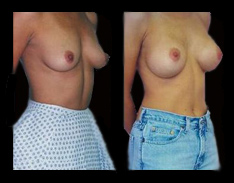Breast Reduction
Female Breast Reduction.
There is perhaps no operation that is more poorly treated in the world of health insurance medicine. Over the past two decades I have watched what was a commonly performed and life enhancing operation become more and more difficult to get covered by insurance. Requirements for grams removed has gone up; criteria for selection have become more and more strict. The most frustrating reason for denial is when the insurance companies ask patients to lose weight before breast reduction surgery will be approved. It has been my experience that reduction of weight on the chest wall improves posture, muscle tone, and the ability to diet and exercise. Breast reduction, perhaps more than any other operation that I perform, is often is followed up with the statement, "I wish I had done this years ago".Are there different types of breast reduction?
While breast reduction can be performed in different ways the most common type of reduction leaves anchor shaped scars. This type of scar pattern, known as a wise pattern, removes the most extra skin from the breast. In moderate size reductions the nipple is usually left attached to the underlying breast tissue which allows for the future possibility (but not guarantee) of maintaining nipple sensation and the possibility of breast feeding. Larger breasts may require free nipple graft where sensation and breast feeding ability are lost. In breast reduction I prefer a central mound technique which allows me to sculpt the shape of the breast. I prefer to leave more fullness near the midline to enhance cleavage.
Will I need a lift as well?
By definition a breast reduction is also a breast lift. The areola is often made smaller as well.
How big will I be?
Good question. Each patient's goals are different and I have to factor in patient goals with technical and artistic considerations. At surgery I reduce one side and when I like the volume and appearance I turn to the other side. It is not an exact science but more about aesthetic judgment.
Will a breast reduction make me look like I have implants?
No, this is a common misconception. Right after surgery patients may look implanty (a lot of fullness in the top of the breast) because the breasts are quite tight right after a breast reduction. As the skin relaxes over the first few months and reduced breasts will ultimately have a softer transition from the chest wall to the breast as do natural breasts.
How is it done?
Most breast reductions are done under a general anesthesia. Surgery takes between two and three hours. Most patients are back to work within about a week. The ultimate healing process as the breasts drop, round and settle is between 6 months to a year. Scars can take a year or more to fully mature.
How do I get it covered by insurance?
If you wish to have this covered by insurance it is important to establish a history with your other physicians of common symptoms such as:
- Neck, back or shoulder pain
- Difficulty with exercise
- Difficulty with hygiene
- Bra strap grooving/arm pain
Male breast reduction
Men may also feel afflicted by enlarged breasts caused by a condition known as gynecomastia. Gynecomastia can be an embarrassing condition. Many men with the condition are embarrassed and always wear a shirt. There are differing treatments for male gynecomastia depending on the age of the patient and the degree of skin laxity. Tighter skin with gynecomastia may in some cases be treated with liposuction alone or liposuction with limited incisions to remove denser breast tissue. If skin is loose or droopy reduction may require skin excision. Because our goal in this surgery is always to minimize the need for scars Gynecomastia is best treated in its early stages when the skin is more elastic.
If you live in Washington, D.C., Maryland, or Northern Virginia and would like to learn more about breast reduction, visit our main cosmetic surgery website or contact the practice of Dr. Adam Tattelbaum today to set up a consultation.
Contact Us
Contact us If you are interested in having breast augmentation in Washington DC, Maryland, or Northern Virginia. Dr. Tattelbaum would be happy to meet with you. Use our contact form to schedule a consultation today!
VISIT OUR GALLERY
PATIENT TESTIMONIALS
Read What Our Patients Had to Say
Thank you Dr. Tattelbaum for my surgery, I cannot thank you enough. Thank you for being patient. Thank you for the work you did on me, I no longer have to wear those uncomfortable enhancers I used to stuff in my bra. Thank you!! You and your staff and the nurses at the center where I had the surgery performed are the most professional and friendly people I have ever met. I was made very comfortable and happy at all times. Thank you Dr. Tattelbaum for what you did for me. May God bless you. Thank you for your care.

